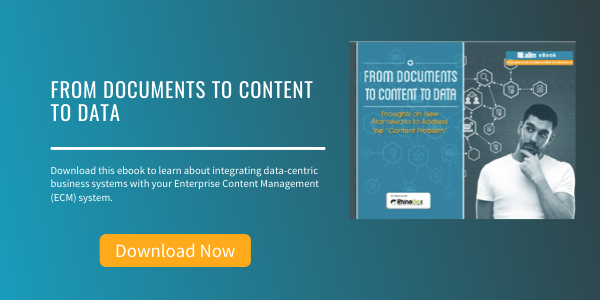
8 Fast Facts About the State of the Document Management Industry
Enterprise Content Management (ECM) | Document Management | Sharepoint and Office 365
-
Saving money is the most significant current driver.
Compared to recent years, cost-saving has taken a clear lead over compliance as the primary business driver for investments in document and records management. Tracking the most significant business drivers over a number of years shows regulatory control and associated compliance risk peaking in 2007 with a fall back in the last two years to cost savings. This is obviously due to the economic downturn - which was in part caused by insufficient regulatory control. We feel that compliance and risk avoidance may rise again once the dust settles over the many regulatory lapses and forced mergers.
-
Email is huge exposure for most organizations.
Despite a small improvement from last year, 55% of organizations still have “little or no confidence” that important emails are recorded, complete and recoverable (62% in 2008). Specifically, 27% consider email attachments to be “very unmanaged.”
-
Legal discovery preparation is mostly ad-hoc.
28% of organizations would take more than a month to produce documents for a legal discovery process, and there is a suspicion that those declaring 2-4 weeks are more in hope than truth, since this period is mandated in a number of data protection and freedom of information rules. As regards the likelihood of being required to produce such evidence, eliminating the “don’t knows,” 18% had been exposed to a legal challenge in the last 12 months and a further 15% in the last three years - a one-in-three chance.
-
SharePoint deployments are all over the map.
There is still a wide disparity in how organizations view SharePoint relative to their overall content management needs and strategies. In 29% of organizations, SharePoint is working in competition with, or in parallel with existing ECM, Document Management (DM) or Records Management (RM) suites, compared to 16% where it is integrated with existing suites and 12% where it is considered to be the only ECM suite. The remainder use SharePoint to “fill in some functions.”
-
Records managers are often being left out of the SharePoint equation.
In 36% of large organizations, IT is managing the SharePoint roll out with no input from the Records Management Department. A further 14% admit that no one is in charge, and it’s completely out-of-control.
-
The single ECM system concept is still alive.
35% of organizations still prefer the path of a single ECM system, whereas 33% plan to use a single sign-on portal to link together multiple repositories.
-
License sales in the main areas of DM and RM will likely hold steady in 2009.
Predicting levels of spend has been difficult this year. Prior to this year, Gartner, for example, had published 8-12% year-on-year growth for ECM. The economic slowdown is affecting that, and in patchy ways across different markets. Based on responses from our survey base, it would seem that license sales in the main areas of DM and RM are set to hold steady, with the biggest falls likely in scanner hardware.
Vendor consulting services will be slightly less affected than independent consultancy services. Despite the usual predictions that outsourcing comes to the fore in times of cost-cutting, outsourcing and bureau services show a considerable cut-back - perhaps reflecting volume-based pricing or reductions in back-file scanning.
Another casualty of discretionary spend reduction is external training for project staff, despite the survey showing that this is the 3rd most likely reason that projects run into trouble.
-
The more exotic the content, the less likely it is to be managed at all.
We asked respondents to rate how well managed each type of content was in their organization, and it is interesting to match that against their level of importance to the business. Paper documents are still much better managed than electronic Office files, although there is a likely effect in many offices that paper filing procedures are deteriorating as electronic content takes over. Instant messages, SMS/text messages, blogs, and wikis are largely off the corporate radar in 75% of organizations. Heavy-handed governance of these nascent channels is considered to be old-fashioned, but given the potential external exposure, lack of policies, and lack of inclusion in the corporate archive is a major risk.
About John Mancini
John Mancini is the President of Content Results, LLC and the Past President of AIIM. He is a well-known author, speaker, and advisor on information management, digital transformation and intelligent automation. John is a frequent keynote speaker and author of more than 30 eBooks on a variety of topics. He can be found on Twitter, LinkedIn and Facebook as jmancini77. Recent keynote topics include: The Stairway to Digital Transformation Navigating Disruptive Waters — 4 Things You Need to Know to Build Your Digital Transformation Strategy Getting Ahead of the Digital Transformation Curve Viewing Information Management Through a New Lens Digital Disruption: 6 Strategies to Avoid Being “Blockbustered” Specialties: Keynote speaker and writer on AI, RPA, intelligent Information Management, Intelligent Automation and Digital Transformation. Consensus-building with Boards to create strategic focus, action, and accountability. Extensive public speaking and public relations work Conversant and experienced in major technology issues and trends. Expert on inbound and content marketing, particularly in an association environment and on the Hubspot platform. John is a Phi Beta Kappa graduate of the College of William and Mary, and holds an M.A. in Public Policy from the Woodrow Wilson School at Princeton University.



